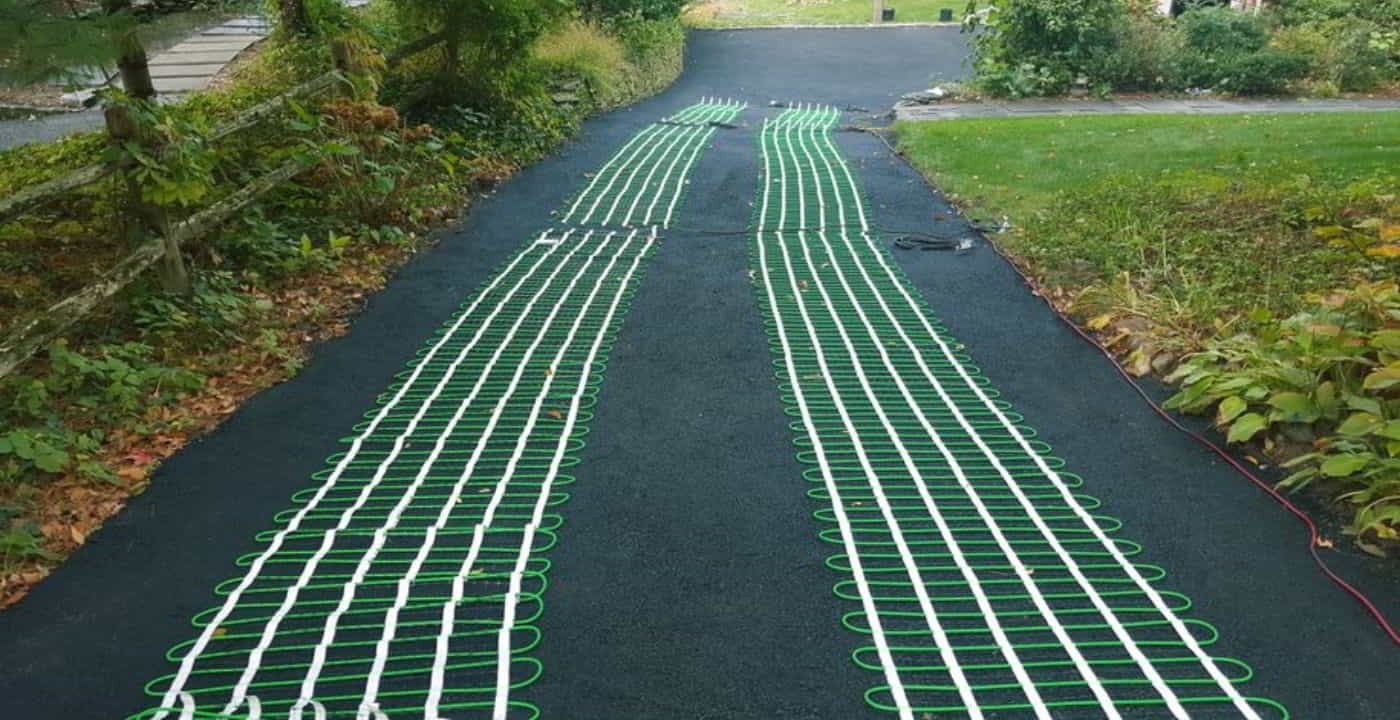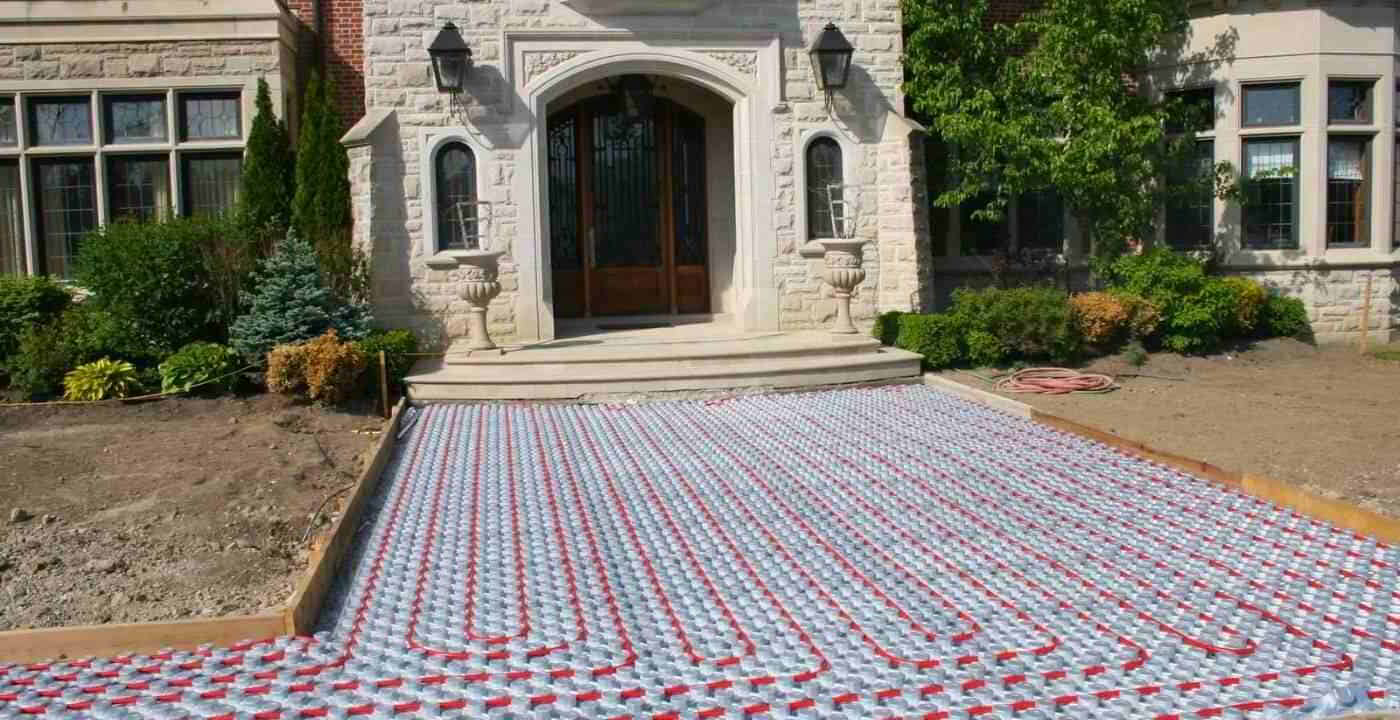Looking at getting a heated driveway and considering hydronic? Well, you’ve landed in the right place.
Read on as we explore the advantages of hydronic heated driveways over traditional snow removal methods, dissect the components of a hydronic system, compare hydronic and electric systems, analyze costs, and provide insights into maintenance and longevity.
By the end, you’ll have a comprehensive understanding to make an informed decision about which heated driveway system best suits your needs.
Key Takeaways
- Hydronic heated driveways are best suited to areas that experience lots of snowfall and extended periods of sub-zero temperatures.
- They are more expensive than electric systems. Sometimes this cost can be recovered through savings on energy bills over time, though not always.
- A hydronic system will require additional space and storage to house the boiler and pump, unlike electric systems that don’t require additional components.
Advantages Over Traditional Snow Removal
Hydronic systems offer several advantages over traditional snow removal methods:
- Consistency: Provides uniform heating, preventing the formation of icy patches.
- Convenience: Automatically operates based on weather conditions, eliminating the need for manual snow removal.
- Safety: Reduces the risk of accidents related to ice and snow.
- Longevity: Protects the driveway surface from freeze-thaw damage common with snow and ice accumulation.
System Components and Their Roles
Understanding the components of a hydronic heated driveway system is crucial for prospective buyers:
- Boiler: The heart of the system, responsible for heating the antifreeze-water mixture.
- Piping: Durable, typically made of cross-linked polyethylene (PEX), these pipes are resistant to both heat and cold.
- Pump: Ensures the continuous flow of the heated mixture throughout the system.
- Manifold: A distribution hub that directs the flow of the mixture into various sections of the piping network.
- Thermostat and Sensors: These components monitor outdoor temperatures and snowfall, automatically activating the system when needed.
The requirement for components including the boiler, pump, and manifold is a key reason that the initial purchase price and costs of installation are typically more expensive than equivalent electric heated driveway systems.
This also increases the complexity of the installation and the design process as you will need to identify a suitable location suitable to house the boiler and other essential components.
Comparing Electric and Hydronic Systems
The choice between electric and hydronic heated driveways hinges on various factors including cost, efficiency, installation, and operational specifics.
This comparison aims to provide a balanced view, helping you make an informed decision based on your specific needs and circumstances.
Electric Heated Driveways

How They Work
Electric systems utilize a network of cables or mats beneath the driveway surface.
These elements heat up as electricity passes through them, effectively melting snow and ice.
There are also systems available that use above-ground heating mats which avoid the requirement to excavate the driveway and install the heating elements beneath the surface.
Electric systems are on demand, usually powered directly from the grid. This means they can be used as and when needed and don’t require a constant supply of energy as is the case with hydronic systems.
Pros
- Simpler Installation: Less complex, making them ideal for retrofitting existing driveways with minimal excavation.
- Reduced Maintenance: Generally require less upkeep than hydronic systems.
- Rapid Heating: Quick activation ensures prompt snow and ice melting.
- Efficiency in Small Areas: Ideal for smaller driveways or targeted zones like walkways.
- Customizable Design: Adaptable to various shapes and sizes of driveways.
Cons
- Higher Operational Costs: Especially for larger driveways, due to electricity usage.
Cost Analysis
For an average two-car driveway, costs range approximately from $2,000 to $14,000.
Hydronic Heated Driveways

Pros
- Cost-Efficiency for Large Driveways: More economical in the long term for larger driveways.
- Energy Source Flexibility: Can run on various sources including gas, electricity, and renewable options.
- Durability and Longevity: Tend to last longer than electric systems with proper maintenance.
- Scalable for Large Areas: Effective for extensive driveways.
Cons
- Higher Initial Costs: More complex and expensive installation, especially in existing driveways.
- Longer Installation Time: Requires extensive work, including significant excavation. Maintenance Needs: Regular checks on boilers, pumps, and fluid levels are necessary.
- Maintenance Needs: Regular checks on boilers, pumps, and fluid levels are necessary.
- Slower Heating Response: Takes longer to heat up compared to electric systems, which can be less efficient in sudden snowfall situations.
- Complex Repairs: Fixing issues can be more challenging due to underground pipes.
Cost Analysis
Installation costs for a standard two-car driveway typically range from $8000-$18,000, reflecting the system’s complexity and additional components.
How Much Does a Hydronic Heated Driveway Cost?
A hydronic heated driveway for an average two-car driveway will cost between $8000-$18,000, with an average cost per square foot of $13-$18.
Below we provide a breakdown of the costs involved.
Hydronic Heated Driveway Costs Breakdown
| Driveway Size | Cost per Square Foot | Average Total Cost (Excluding Boiler and Pump) |
|---|---|---|
| 324 to 480 sq. ft. | $13 to $18 | $4,150 to $8,700 |
Additional Expenses
| Item | Cost Range |
|---|---|
| High-Efficiency Boiler | $3,200 to $9,000 |
| Pump | $500 to $800 |
Remember that these are approximate cost estimates which can vary based on various factors such as location, contractor rates, and specific project requirements.
It is always recommended to get a quote from local installers to get an accurate cost estimate for your specific heated driveway project.
Hydronic systems are more expensive than alternative options like electrically heated driveways because they are more complicated and require additional components like the pump and the boiler.
Maintenance and Longevity
Hydronic systems also require ongoing maintenance to ensure they continue to operate at full capacity.
Regular maintenance includes checking the boiler, pipes, and antifreeze levels.
When properly maintained a hydronic system can be expected to last between 10-15 years or longer.
Electric systems require little to no maintenance and, due to their lack of additional components and mechanics, often last anywhere from 20-30+ years.
Understanding Hydronic Systems
Efficiency and Suitability for Larger Areas
Hydronic systems are particularly efficient for larger areas due to their ability to maintain consistent heat distribution over extensive surfaces.
This efficiency is achieved through the system’s design, which allows for consistent and uniform heat distribution.
The hydronic system’s boiler can be adjusted to different energy outputs, making it adaptable to varying driveway sizes, shapes, and surface materials.
This adaptability ensures that no matter the size of the area, the system remains energy-efficient, reducing the overall operating costs in comparison to other heating methods.
How They Work: Antifreeze and Water Mixture
The core functionality of a hydronic heated driveway lies in its circulation of a heated mixture of antifreeze and water.
This mixture is heated in a boiler and then pumped through a network of buried pipes beneath the driveway.
Here’s a step-by-step explanation:
Heating the Mixture:
A boiler, which can be powered by various energy sources such as natural gas, electricity, or solar power, heats a mixture of water and antifreeze.
The antifreeze component, typically propylene glycol or ethylene glycol, prevents the mixture from freezing in cold temperatures, ensuring a consistent flow.
Circulation through Piping:
Once heated, this mixture travels through a closed loop of pipes laid beneath the driveway’s surface.
The layout of these pipes is strategically designed to cover the entire area evenly, ensuring no cold spots are left untouched.
Heat Transfer to the Surface:
As the hot liquid passes through the pipes, heat is transferred from the pipes to the driveway’s surface.
This process effectively melts any snow or ice that accumulates on the driveway.
Recirculation:
After releasing its heat, the now-cooled mixture returns to the boiler, where it is reheated and recirculated.
This cycle continues as needed to maintain a clear and ice-free driveway surface.
Are Heated Driveways Worth It?
Heated driveways come with a bunch of perks that might make you think they’re a smart choice:
Easy Living
Forget about breaking your back shoveling snow or dealing with a snowblower early in the morning.
Heated driveways melt snow on their own, keeping your driveway clear and making it easier for cars and people to get around.
Stay Safe
By getting rid of ice, heated driveways cut down on the chances of someone slipping, falling, or getting hurt.
This means a safer space for you, your family, and anyone visiting during the chilly months.
Less Work
A heated driveway means you can skip the plowing, salting, and throwing down chemicals to fight off snow and ice.
This could mean spending less on upkeep and avoiding damage to your driveway over time.
Boost Your Home's Worth
Putting in a heated driveway can up your home’s market appeal. It’s both a fancy and useful upgrade that might catch the eye of future buyers.
But, here are a few things to mull over before you decide a heated driveway is right for your home:
Upfront Costs
Heated driveways aren’t cheap to put in, especially when you compare them to regular driveways.
It’s important to look at your finances and see if the perks are worth the initial cash you’ll need to lay out.
Running Costs
Sure, heated driveways mean no shoveling, but they’re not free to operate. You’ll have ongoing costs for the electricity or fuel that keeps the driveway warm.
Getting a handle on these expenses will help you figure out if a heated driveway makes sense money-wise in the long haul.
Your Local Weather
How much you’ll benefit from a heated driveway depends a lot on your local weather.
They’re great for places with a steady amount of snow. But, if you live somewhere that gets buried under heaps of snow or where it’s super cold, the system might need a little help handling everything.
Deciding on a heated driveway involves balancing the cool benefits with the real costs and seeing if it fits your lifestyle and budget
FAQs
How does a hydronic heated driveway work?
It uses a network of pipes under the driveway, circulating a mixture of antifreeze and water mixture usually heated by a boiler.
Is hydronic or electric snow melt better?
Hydronic snowmelt systems are better for larger areas and can have lower operating costs, while electric systems are suited for smaller areas and have a lower upfront cost.
Can I control the temperature of my hydronic heated driveway?
Yes, modern hydronic heated driveway systems can be equipped with smart controls that allow you to adjust the temperature and operation times.
This means you can set the system to activate based on specific weather conditions or schedules, optimizing energy use and ensuring your driveway is clear when you need it.
What happens if a leak occurs in the hydronic system's piping?
If a leak occurs, it’s usually detectable through monitoring system pressure or antifreeze levels.
Repairs might involve locating the leak and accessing the pipe, which could require some excavation. Choosing durable pipes and professional installation reduces the risk of leaks.
Melting Over the Choices: Picking Your Path
Whilst hydronic systems do have several advantages, particularly with larger driveways in regions with extended colder temperatures, for many people an electric system may be better suited for their specific needs and conditions.
Electric systems are more reliable, last longer, require little to no maintenance, and are usually a lot cheaper than hydronic systems.
If you’d like to discuss your requirements or circumstances with an expert, feel free to get in touch at any time.





